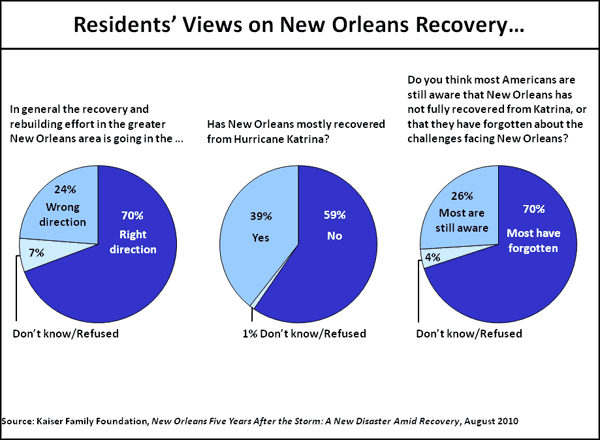Pulling It Together: New Orleans Five Years After the Levees Broke
President Obama’s visit to New Orleans on August 29, five years after Hurricane Katrina and the levee failures nearly destroyed the city, presented an opportunity for him to deliver a message on behalf of us all: The country still cares.
It was a timely message. Seven-in-ten residents of New Orleans told us in our recent survey that they believe the rest of the country has forgotten them and the difficulties the city still faces in its recovery. The survey, the third in a biennial series on the experiences and opinions of New Orleans residents, is part of the Kaiser Family Foundation’s continuing work to get the facts out about the recovery in New Orleans.
There are signs of remarkable progress in the city. Three-quarters of the people of the city are optimistic about the future. Nearly two-thirds of New Orleans residents say their lives are back to normal and 70% say that the rebuilding effort is going in the right direction, up from 56% in 2008. They applaud the success in bringing back tourism and conventions (87% say they have seen a lot or some progress), repairing the levees (65%), improving transportation (62%), rebuilding some neighborhoods (59%), and making strides in schools (57%), housing (50%) and health care (49%). Over the three surveys we have conducted in New Orleans since Katrina, we have seen steady improvement in most areas, including in race relations. For the first time since 2006, more residents say that race relations are getting better (23%) than say they were getting worse (15%). The proportion of African Americans who see bias in the rebuilding process has fallen from 55% in 2006 to 30% now. Interestingly, more residents see the city as divided by “class” (33%) than by “race” (17%).
But the city that is recovering is a much different New Orleans than before Katrina. The new New Orleans has a population about a quarter smaller than it was before the storm, with whole neighborhoods still just a shadow of what they once were. New Orleans is far from the centers of political and media power in the country and the populations most affected by Katrina were mostly lower income and minority Americans. If a man-made or natural disaster had dislocated a quarter of the population of New York, Boston or San Francisco, and devastated Brooklyn, the Back Bay or the Marina District, it is hard to believe that the rest of America would have resigned itself so quickly to the idea that those residents would never return home and those neighborhoods might not be rebuilt.
The new New Orleans faces real challenges. Over half (57%) of young professionals, a key to the city’s future, are pessimistic about their career prospects and 37% of those under age 30 are considering leaving. African Americans are much more likely to say they have not recovered from Katrina than whites (42%, compared to 16% of whites). And in a country where every poll finds the economy and jobs as the runaway No. 1 issue, in New Orleans it is crime (cited by 41%) and picked by residents three-to-one over the No. 2 concern, the gulf oil spill (12%).
Concern over the potential economic and environmental effects of the spill was so great in New Orleans when we surveyed in late June that more people picked the oil spill than Katrina (49% vs. 40%) when asked which calamity ultimately will be more damaging to the region.
We asked the people of New Orleans what they liked best about their city. Overwhelmingly they said its culture—nothing else was even close (cited by 35%, compared to 12% for tourism, the second most popular response). We can count progress in jobs and clinics and schools and engineers can test the strength of levees, but the measure that is of greatest importance to the people of the city itself will be the hardest to gauge as the recovery progresses and the makeup of the city changes.
At a time when our nation is struggling with a stubbornly sluggish economy, one war winding down and another intensifying, the challenge of rebuilding New Orleans may appear to some to be little more than a regional concern. But Katrina, more than any other single event in recent memory, was the symbol of failed government. There could be no more tangible demonstration of government’s ability to deliver than a clear success story in New Orleans. Despite real progress in the city five years after the storm, the job of resurrecting New Orleans is far from done.
Drew Altman, PhD, is president and CEO of the Henry J. Kaiser Family Foundation in Menlo Park, California.
[This column expands on an op-ed published in The Washington Post on Sunday, August 29, 2010.]

